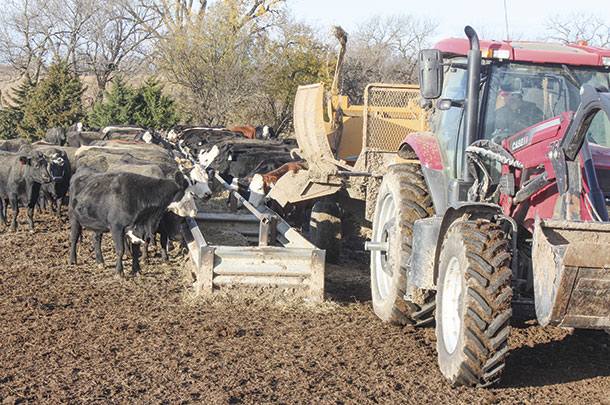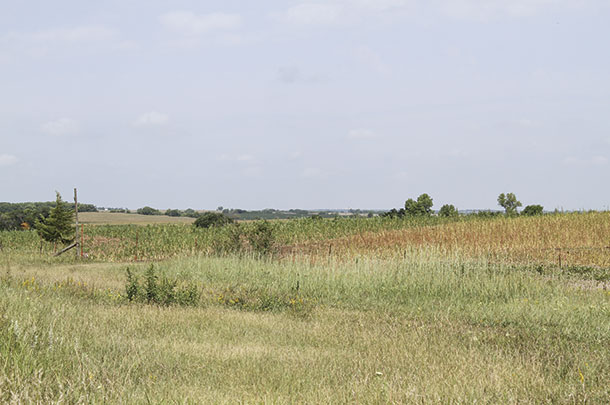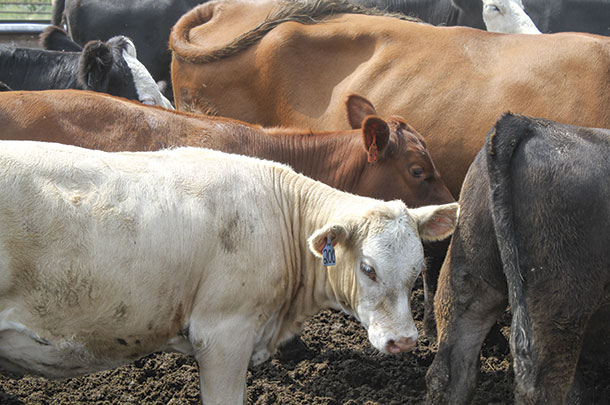Diederich worked off the ranch for the Kansas State University Extension and other operations closer to Manhattan before returning to the family ranch in 1990. They currently run a herd with slightly more than 300 cattle with a successful timed AI and finishing program.
One of Diederich’s biggest priorities is maintaining a low cost of production through management practices that keep his herd healthy and productive, and keeps him in the black. Around 2011, he started exploring the economics of different options for supporting their growing herd. Diederich says that in the past, the biggest limiting factor for cow-calf producers was how much pasture they could provide for each pair.
He figured he could condense his herd in a pen and raise them more cheaply than if he purchased more pasture for them. Diederich owns another piece of ground about a mile away from the home spread and decided to start developing 90 acres of it into an intensive grazing system.
Diederich built a confinement pen with a ridge built down the middle where they have their feedbunk. They put down fiber mesh used in road construction as a base. On top of that, they put down about 4 inches of crushed rock, then covered that with about 8 inches of lime to create an all-weather surface that makes it easy to drive in and out of the pen and is easy to clean.

He says this is a much better setup than using concrete as a base. “Invariably, with concrete, there will be moisture or manure on the concrete, and the bulls will jump up there and try to breed cows, and they will get spraddled,” Diederich says. “We spend a lot of money on bulls, and we do not want a slick surface within this confined area. It’s not like [lime] can’t get slick, but the majority of the time, they have better footing on it.”
They built two of these units, each with adjoining grazing land where they practice an intensive grazing system. The efficient system they have today is a result of a lengthy process of trial and error. “Hindsight is great looking back at it because, when we started, we talked to people – and nobody was really doing it, and they didn’t really have any recommendations, so when we started it was a lot of, ‘Huh, let’s run the fence over to that mulberry tree and see how it goes.’” It has evolved into a system of polyrope paddocks they flash graze between stints in the pen.
Nutrition during intensive grazing
Diederich’s biggest challenge when he started intensive grazing was getting all of his forage eaten down before it got too mature or before the spring rains made the paddocks a muddy mess.

He grazes a BMR sudangrass that, while highly digestible and high in tonnage, has a very short window of grazing time between prohibitively high nitrogen levels during early growth stages and rapid plant growth later on. Diederich is a firm believer in what he terms “redneck science” or watching the neighbors. He noticed people in the area ran cattle on wheat pasture despite high nitrogen levels in the plants.
He also noticed cows grazing on corn crops heavy on nitrates without getting nitrogen poisoning and decided to make some changes in his own grazing strategy; he started grazing earlier despite the high nitrogen levels to get more out of his sudangrass pasture.
According to Diederich, the conventionally “safe” nitrogen threshold in grazing forage is about 3,000 parts per million (ppm). His forage samples ran between 36,000 and 42,000 ppm. “We should have killed them 10 times,” he jokes. He first tried it out on a group of cull cows with good results. “They got really loose, they got fat as heck, and they didn’t appear to have any divots.” He tried it next on a group of pregnant cows with the same positive results and turned it into a permanent part of his routine.
Nutrition in the pen
Diederich says it was a learning process to figure out the nutritional needs of his herd in the drylot pen. “There are no guidelines for feeding confined cows. When you put them in a small area where they are not burning calories and walking, what do they really need?” he says. “We found it’s probably somewhere around 15 to 20 percent less when you limit the need for cows to be walking and you bring the feed to them.”

He also uses an ionophore to help with feed efficiency along with adding a base mineral mix to the ration to make sure all macromineral and micromineral needs are being met. “I think there are a lot of cows who, if faced with free-choice minerals, never touch it,” he says. “Force-feeding minerals makes a huge difference with general health and makes a huge difference how the calves perform down the road.”
Limiting feed in the pen
Diederich uses a limit-feed system to cut down on waste and make sure each cow gets the proper amount of nutrients needed. “It’s a different science when you have concentrated cows,” he says. “To make it work with feeding, you have to limit feed because if you don’t, you’ll just waste feed and make more manure, and then it’s hard to manage nutrition for the cows. When you limit feed, they all line up and they eat, and that’s it.”
His feed ration, depending on what he has at hand, can vary from 17 pounds per cow on an as-fed basis up to 52 pounds. He also feeds extra corn in his ration. “In a limit-feed diet, we adjust the rumen to it slowly and feed more corn because, in calorie content, corn is cheaper than prairie hay or any other roughages.”
He also feeds distillers grains as a protein source and supplements with whatever roughages he has at hand, like straw or ground cornstalks or hay. “Feed is 80 percent of the cost of production and, if you’re confining your cattle, you can control what the wastage is, so you figure out how to meet their needs but not overfeed them.”
Diederich says it takes approaching herd management from a different angle than conventional operations to make a confinement system successful. “You’ve got your cattle confined. What’s the worst thing about it? They’re in a pen. What’s the best thing about it? They’re in a pen. So you can look at your management and see what you can do to make that work.” ![]()
PHOTO 1: Mark and his wife, Evelyn
PHOTO 2: Diederich’s feedbunks are built 26 inches high to keep cows from tossing feed out and trampling on it.
PHOTO 3: Two grazing paddocks: before and after.
PHOTO 4: Diederich crossbreeds Black Angus, Simmental, Charolais, Red Angus and Hereford genetics to get maximum heterosis in his calves. Photos by Carrie Veselka and Evelyn Diederich.

-
Carrie Veselka
- Associate Editor
- Progressive Cattleman
- Email Carrie Veselka








